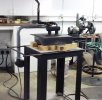It does differentiate by density. There is not data for 4 or 6 pcf at 2000°F.
The difference in thermal conductivity ranges from 20-40% higher on 4 pcf vs 8 pcf, from 500 to 1800 °F.
Y'know, I looked at that chart for like a half hour like a monkey doing a math problem before I found what was right in front of my own face.

Anyone wanna help me pull my foot outta my mouth?
Anyhow, JT - if the 2" is going to be just wool, no, the wall thickness shouldn't be a problem, but if the interior is a 2" thick wall of castable, then, yeah, it's going to take a long ass bloody time to heat up. The inside will be hot enough to forge in, but the castable won't be radiating its heat inward as nice and even yet until it gets a good glow on. You'll burn a lot of gas forging in something like that, but if you're welding a bunch of large billets and going to be at it for a long time, it might actually save you fuel, because once it gets up to temp, it'll want to stay that way a good long while too, and you can keep it good and hot at an idle for a good long time.
I had a forge with a 1" wall of castable, insulated by 2" of 8lb Kaowool around the outside of that that I had wanted to use for welding, but I gave up on the beast after a 45 minute burn at full bore didn't get the liner up to temp

I'm not yet welding in my current forge, but it's built for it, with a bubble alumina refractory lining the inside, surrounded by 2" of 8lb "superwool" (the less nasty to your health version of Kaowool), all lined with ITC100. I've slagged some metal in it, and coated a bar of steel with borax and melted the borax in it just to see how it would react, and it hasn't even noticed yet.

